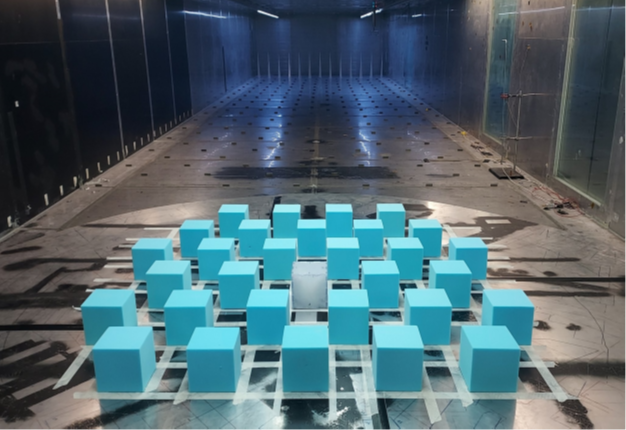Lead Supervisor: Dave Birch, School of Mechanical Engineering Sciences / Centre for Aerodynamics & Environmental Flow / EnFlo, University of Surrey
Email: d.birch@surrey.ac.uk
Co-supervisor: Simao Marques, School of Mechanical Engineering Sciences / Centre for Aerodynamics & Environmental Flow / EnFlo, University of Surrey
It is more important than ever for us to be able to understand how wind and the built environment interact to distribute emissions around densely-populated cities. As the links between air quality and health outcomes become clearer, practical air quality models are becoming a critical tool for urban planning and policy.
One very powerful technique for developing these models is through wind-tunnel simulation: a flow emulating the Earth’s atmosphere is generated over an urban-like environment, and the dispersion of pollutants is simulated using small amounts of specific tracer gases. The concentration of these gases as they evolve in time can be measured at a specific point in the flow using a specialized sensor. However, these sensors tend to be very big (which means they can’t easily be used in smaller model urban landscapes) and expensive (which means that the number of simultaneous measurements is usually very restricted). As a consequence, most wind-tunnel studies in pollutant dispersion focus on the time-mean concentration fields, and occasionally some higher-order statistics at a specific point. However, there is growing concern that adverse health effects may be associated as much with the ‘acute’ peak levels of pollutant concentration rather than just the ‘chronic’ mean- and the time-evolution of the entire concentration field has not been accessible experimentally.
However, recent work at the University of Surrey using a model building with a very large number of simultaneous surface pressure measurements has demonstrated that there exist correlations between the surface pressure fields and the concentration fields1. By using a very large number of pressure measurements together with the small number of concentration measurements available, it is possible to infer instantaneous ‘snapshots’ of the concentration profile around the building with reasonable confidence. The value of this capability is twofold: first, this could provide the first data sets of their type, allowing computational models to be better calibrated- and second, it could demonstrate that with nothing more than a few air quality stations and a large number of inexpensive pressure sensors, a ‘smart building’ could decide whether or not it is safe (from an indoor air quality standpoint) at any moment for the occupants to open a window.
Although pressure and concentration fields are linked, it isn’t at all clear yet how they are linked. However, because very large data sets demonstrating this are available, it is an excellent candidate case for the application of machine learning or other artificial intelligence approaches. The purpose of this project is therefore to develop the algorithms and techniques required to generate extremely valuable concentration fields from readily available pressure data in an urban environment, while collecting whatever wind tunnel data is required in order to calibrate and validate the algorithms.

Training Opportunities
The successful candidate will have the opportunity to work in one of only about five atmospheric wind tunnels in the world which can model stable and unstable boundary layers. The University of Surrey specialises in advanced, automated measurement systems and instrumentation, and the successful candidate will develop broad, transferrable skills in measurement science and applications. The candidate will also be trained in the use of advanced machine learning/AI data processing algorithms specifically for environmental science.
Student Profile
This project would be best suited to a student having a background in mechanical engineering, aerospace engineering or mathematics, with an interest in aerodynamics and environmental science.
Knowledge of numerical processing software (such as MATLAB) would be advantageous, as would any experience in experimental aerodynamics. Background in CFD would also be a significant asset.
A desire to learn about experimental instrumentation and machine learning is also necessary.

